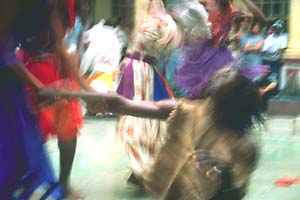If I work they kill me,
If I don't work they kill me,
Whatever I do they kill me.
Whether I live, die or love...
Nicolas Guillen "Cuban Laments"
The city of Gantanamo was founded among the mountains in the south east of the island facing Haiti. This city has a large population of Haitians who came to Cuba before the revolution to find work and settled. These groups maintain their African and French influenced cultural identity in Cuba and live as both Cubans and Haitians. Like other people of Cuba, they have all but lost hope, but they still wait for economic conditions to improve. In the meantime, they are enriching Cuba's ethnic structure with folklore known as Tumba Francesa, an established part of Haitian culture.More Cuban facts
Ernesto Che Guevara's lives on in photographs in Cuba and all over Latin America.
In the city of Varadero, the meeting room of the Communist Party is quiet these days. While the generation who brought about the revolution enjoy the comfort of success, the new generation party members strive to maintain the difficult and unpopular status quo. If Guevara were still alive today would he be able to find a remedy for Cuba's problems? Although an Argentinian, Guevara fought to rid Latin America of colonialism and to bring about freedom. In the first important war he fought to free Cuba. After the revolution he was rewarded with Cuban citizenship and given important roles in government. When the new system was established, Guevara began waging similar wars in other countries, training others in his own advanced guerilla tactics until October 1967 when he was killed by the Bolivian army at the age of 39.

Vardero Beach. A bridge forms the only entrance to the town and this beach on a small peninsula. A police check point on the bridge prevents Cuban citizens from entering. The majority of people in Varadero are Italian tourists.

Havana is a city of unpainted walls, all colours bleached out by the sun. The south wind called La Cuaresma peels the top layers of paint, exposing the old colours underneath. The facades of Havana -- like the faces of its people -- show the weariness of the years.
Santeria belongs to different peoples brought from different regions of Africa to the Caribbean islands as slaves at the beginning of the "New World" slave trade. Consequently, the drumming music, religion and culture of this nation were all introduced to the Caribbean Isles. The people brought to Cuba were mostly from the Nigerian region where the Santeria religion is widespread, and with them the religion and slavery came to Cuba. Today, Santeria is the accepted religion of Cubans, reflected in the folklore irrespective of their race. This Cuban has given permission to a saint to enter his body and has entered a trance-like state with the aid of music.

The Cubans, who have all experienced hard economic times, now at least in part depend upon the wealth of foreigners with dollars to spend visiting their country, and in spite of this inequality wait helplessly for the system to be reformed.In recent years, Cubans have learned to earn dollars by entertaining tourists in the living rooms of their homes. These salons have turned into small restaurants. In this little room immediately behind Havana cathedral, a community takes the first small steps towards capitalism, and the family shows its excitement felt by earning its own money in the flurry of entertaining a foreign guest.
In Santa Clara the Himenez family, whose relatives are all in America, has been waiting since 1959 for economic conditions to improve.On a hot winter's evening, Antonio was organizing a street party for his father. All the 80 year-old's friends would gather to hear Roberto's voice once more. In 1959, until the people's revolution led by Fidel Castro, Roberto and a group of musicians played music in the country's most famous casino tucked in narrow Havana street. In the winter of 1996 a nostalgic sunset reunion was to be held in order to bring back the pre revolution atmosphere of Cuba and allow a chance for them to abandon their bodies to the rhythms of salsa.
At the side of the road home-brewed beer is being sold from a water tank pulled by a tractor. A comparable name-brand can of beer would cost a Cuban three days of wages. Across the road, "churros" are being sold from a house window. Flour has become one of the scarce ingredients in Cuba in recent years, and accordingly churros are made from potatoes.
These street sellers are signs of change. In order to lighten the economic hardship a little after the break up of the Soviet Union, in the early 1990's Fidel Castro's government made legal provision for the people to trade among themselves. Within the framework of this program, people are able to sell food they produce from home or at the street markets which began to crop up around two years ago.
The people forced to trade in Cuban pesos with fellow Cubans took to doing the same business with foreigners. Providing a couple of foreigners with lunch in a Cuban house brings in $10, the equivalent of a monthly wage. Those able to trade with tourists have an economic power inaccessible to others, and two social levels are evident in Cuba: Peso Cuba and dollar Cuba.
The first signals of a changing Cuba came to us from Castro's October 1995 press conference in Uraguay when he invited tourists of the world to Cuba. "Our prostitutes are the most educated and healthy in the world". These words reflected Cuba's urgent need both for tourists and a change in the country's economic policy. Castro has given his country free education and health care, and one of the highest literacy rates in the world, but yet has been pushed into a corner.
He has also made his presence felt in recent years with the adoption of a more open domestic policy. Political meetings have been combined with music and concerts. Music is the best vehicle for reaching Cubans, for it is an ever present element of Cuban life. The Spaniards and African slaves each brought their own music to the island, resulting in an intricate synthesis of African rhythm and supple Mediterranean tones with elements of American jazz-influenced Caribbean music and Columbian and Porto Rican salsa.


In addition to Havana University, there are 35 schools of higher education in the country. Cubans have a much higher level of education than people of other Caribbean countries.
Santeria, the most widespread religion of the island, is inseparable from the African influenced music -- worship consists of giving oneself up to the rhythm. Like the words of Cuban exile Gloria Estefan, "The Rhythm is Gonna Get Ya". During the weekend, religious ceremonies are conducted all over the island to the accompaniment of three drums. By dancing for hours to a certain rhythm, people can align their thoughts and call on the saints. A saint answers the call by entering the body and speaking through one of the group.
Slave owners tried to force their slaves to worship Christian statues, but these were secretly given the names of their own sacred spirits. In time, Santeria and Christianity fused into the present form. Cuban Christianity has reacquainted itself with the witches and magicians killed off in the Middle Ages, but this time in an African rooted version. The famous santero, Tony, predicts the future with sea shells, stones and bones and can break spells already cast. Visitors from all over the world come to his Santa Clara home, and he warns tourists to be wary of exploitative santeros who may put a spell on them to keep bringing them back.
During the people's revolution the churches representing white power, Europe and colonialism did not support Castro. After the revolution, many were closed down and many priests were imprisoned. The simplicity and enjoyable form of Santeria worship has ensured its popularity. Like several Caribbean islands, Cuba has preserved its African identity. Today Cuba is full of artists proud of this fact who work to inspire the community with African values. The band "Afro-Cuban", for example, offers a kind of Santero rap and the painter, Salvadol-El Pintor, creates street murals and sculptures which bring Santeria culture to life. According to the artist, the striking eyes in his paintings represent the people keeping a watchful eye on how their state functions.
To ensure that all the population is fed, food is distributed free of charge via a ticket system. In the winter of 1996, the monthly allowance per person was rationed to 7 eggs, 2 kg sugar, 1/2 kg rice and 2 packets of cigarettes. Other requirements can be bought in pesos from the markets, although on a $10 income there is little chance of this. Any opportunity of earning dollars naturally eases the difficulties of life, as coffee, pasta, rum and canned products can all be found in the state supermarkets.
In Havana, the best escape route from all these problems is being in love. Talking politics is prohibited and little can be said about the economy, so the people are directed to social topics. Life takes place on the streets, and everyone in Cuba knows each others business. Soap characters are one of the most discussed topics, and every night between 8 and 9 life stops in Cuba as the population stops to watch soaps made especially in Brazil and Venezuela, carefully lacking in the luxuries of modern life, politics and economics. The subject always concerns love and relationships. For Cubans, it offers a way of escaping Cuba for an hour.


This Cuban girl from the city of Santiago de Cuba has the arresting, passionate looks of the regional people. In the east, the pace of life is a little slower, more enjoyable, more indifferent to the difficult conditions. . La Habanera (Havana girl)... The residents of Havana live the life of the whole country. With the problems of country and city near boiling point, she meets her lover at the coastal strip called Malekon..
To witness the power of love in this small country, one need merely to go to the coastal strip named Malekon. Here lovers can be seen at all times of day.
For Cubans, "tourist" usually means Italian. In the last 10 years several new hotels have opened, some of them with Italian or Spanish investment. Varadero sits just two hours drive from Havana, reserved for tourists and citizens only. A police check point on the bridge -- the city's only entrance -- prevents Cuban girls or illegal taxis from entering the region.
The naturally beautiful Santiago de Cuba at the southern tip of the island is another city enjoying tourism. The city has a higher percentage of black residents than other parts of the country, and the influence of the African culture brought by migrants from other Caribbean islands has made Santiago de Cuba a hot bed for music, Santeria, art and carnival. The people of this region seem to have more spirit, apparently less careworn than those in Havana.
Is tourism the savior for the Cuban economy? According to Fidel and Raul Castro, tourism and export of medicines will satisfy Cuba's need for foreign currency, although it would be a mistake to think that only two industries could cure Cuba's hemorrhaging economy. Castro has directed the population towards professions valued in capitalist regimes. This year Havana University awarded degrees in international accounting, finance and property law, but -- for the first time -- none in philosophy.
The Cuban people are proud of their survival in spite of economic embargoes imposed by most of the capitalist world, yet they have remained powerless observers of the disintegration of the communist order they were linked to. The two worlds that have evolved in Cuba over recent years have been enough to destroy the economic balance between people. Taxi and restaurant ownership are viewed as lucrative sources of income, as are other more risky and less regular forms of employment. The changes brought by the transition to the free market create winners and losers as is the case all over the world. Today, Cubans' efforts are being concentrated on becoming integrated into the world of the dollar. Unfortunately, at the moment This can only by achieved unlawfully and in conflict with their true feelings.
Today the Caribbean country of love and revolution is like a pregnant woman. The baby's father is of a different colour. The name of the woman's husband was Fidel and now it's Raul. Until now, their power has sufficed to make him head of the household and to win the woman's respect. For years she has wanted the child of her dreams but has been shy of making her husband comprehend the situation. The father of the unborn child is green, his name is "Dollar," and he lives in the next apartment. We are neighbours. From time to time we can go next door to drink a very sweet cup of Cuban coffee and see the new developments.